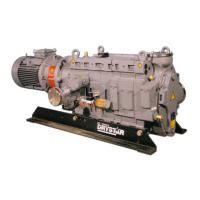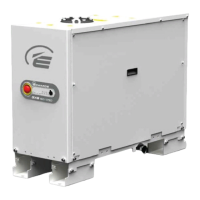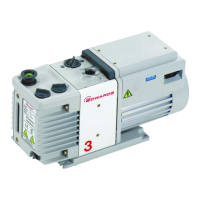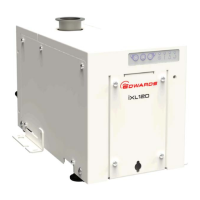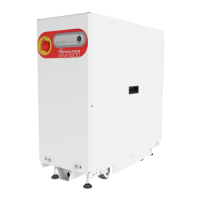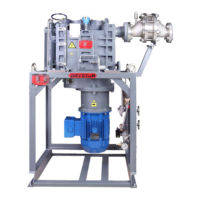© Edwards Limited 2012. All rights reserved. Page 3
Edwards and the Edwards logo are trademarks of Edwards Limited.
Introduction
A705-61-880 Issue M
1.3 Gas system
Refer to Figure 1. The pump has a shaft-seals purge system and a gas-ballast system.
You can connect a dry compressed air supply to the shaft-seals purge inlet (22). The shaft-seals purge pipeline then
delivers the dry air purge to the shaft-seals. This dry air purge: ensures that the shaft-seals are maintained at a
positive pressure during pump operation; prevents the entry of corrosive or toxic process vapours into the pump
gearbox; prevents contamination of the process gases by pump oil; prevents damage to the shaft-seals by debris.
As supplied, the gas-ballast system can deliver ambient air to the pump gas-ballast inlet. The air-flow is filtered and
is controlled by a valve (10). A check-valve (Figure 5, item 10) prevents the escape of process gases out of the gas-
ballast system into the local atmosphere.
If required for your application, you can connect dry nitrogen supplies to the pump, to deliver nitrogen gas-ballast
and nitrogen shaft-seals purge instead of air: refer to Section 3.10.
1.4 Cooling system
Note: The direct cooling system fitted to the pump is suitable for pump operating temperatures (measured at the
position shown in Figure 1, item 3) of up to 45 °C, (113 °F). If your application requires pump operating
temperatures of 45 to 90 °C (113 to 194 °F), we recommend that you fit an Indirect Cooling Kit accessory:
refer to Section 7.4.4.
Refer to Figure 1. The pump has a direct cooling system, in which cooling-water (connected through the water inlet,
7) circulates around the pump-body and then passes out of the pump through the outlet (2). The pump-motor (16) is
air-cooled by an integral cooling-fan (19).
A thermal snap-switch box (4) is fitted to the pump-body. The snap-switch box has two thermal snap-switches:
The output of the warning thermal snap-switch will go open circuit when the temperature of the pump-body
is higher than normal. Use this output to provide a warning of high pump temperature.
The output of the shut-down thermal snap-switch will go open circuit when the temperature of the pump-
body is too high. Use this output to shut-down the pump when it is too hot.
1.5 Interstage relief valve
The pump has an interstage relief valve (12) fitted in a pipe between the pump-outlet and the last stage of the pump.
The valve is normally held closed by its own weight, but opens depending on the pump-inlet pressure, as follows:
At pump-inlet pressures of 300 mbar (3 x 10
4
Pa, 225 Torr) and above on the GV250, and at pump-inlet
pressures of 200 mbar (2.0 x 10
4
Pa, 150 Torr) and above on the GV400, the interstage pressure forces the
valve open. This allows process gases to pass directly from the second stage into the pump-outlet, without
compression in the third stage of the pump.
At pump-inlet pressures below those specified above, the interstage pressure is low and the valve is held
closed. Process gases pass through all stages of the pump; that is, the process gases are compressed in the
third stage before they pass into the pump-outlet.
The interstage relief valve allows the pump to provide a constant pumping speed from atmospheric pressure down
to 10 mbar (1 x 10
3
Pa, 7.5 Torr) and also prevents excessive electrical power consumption by the pump-motor when
the pump starts.
1.6 Drive operation
The pump has a flexible drive coupling which transmits the drive from the pump-motor (16) to the pump rotors.
Refer to Figure 10. A coupling hub (14) is fitted to the pump shaft (9) and a drive hub (16) is fitted to the motor
shaft (18). A coupling insert (15) fits between the coupling and drive hubs.

